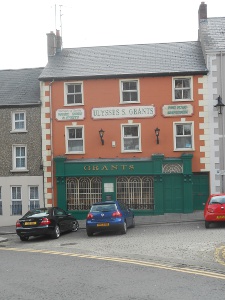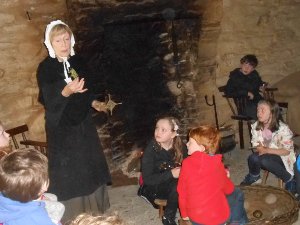Our introduction to Northern Ireland was a week-long stay in Omagh, where we traveled with the intention of looking for records of various ancestors.
 The Grant family store
Dublin is a large, complex, fast-moving noisy city. Omagh is a town.
But it is also intense, at least near the center, where everybody has a place to go and errands to run. Walking downtown one day to do our own errands, we kept running into the same jolly man. Finally we all stopped for a quick chat. We told him we like his city, and he said, "but it's only a town." Nevertheless, he is clearly happy here.
The Grant family store
Dublin is a large, complex, fast-moving noisy city. Omagh is a town.
But it is also intense, at least near the center, where everybody has a place to go and errands to run. Walking downtown one day to do our own errands, we kept running into the same jolly man. Finally we all stopped for a quick chat. We told him we like his city, and he said, "but it's only a town." Nevertheless, he is clearly happy here.
The Irish continue to impress us with their friendliness. Everybody says hello, even if sometimes it is just a mutter. We counted the people with whom we interacted this morning: seven. This includes two librarians, one tourist information staffer, the smily man on the street, and several store clerks. Everybody wants to help the visitors (we don't think we appear more dim than normal -- they're just naturally helpful). In Dublin it seemed that we heard a lot of different languages. Here we are aware of American and English accents, plus the more noticeable local accent which is heavy with vowels.
We are in County Tyrone looking for traces of some of Elsa's family who emigrated to America about three hundred years ago. Not expecting much in the way of documentation, we're nevertheless learning lots about local history, which includes Presbyterians.
Ulysses S. Grant's family home is here, and their store is still open. One of the librarians has written a paper on Davy Crockett  The memorial mirrors
which she has given to the Alamo in San Antonio, Texas. And the woman at the next table over at lunch spoke about her love for Elvis.
The memorial mirrors
which she has given to the Alamo in San Antonio, Texas. And the woman at the next table over at lunch spoke about her love for Elvis.
We soon learned that Omagh was the site of a bombing in August 1998. The Good Friday Agreement had just been signed, and England and Ireland and Northern Ireland were desperately anxious to make it work. This meant a form of amnesty and a de-escalation of violence. The Real IRA then planted the deadliest bomb ever - a 500-pounder in downtown Omagh. Their warning said Court House, so the police shooed people away from the courthouse. But bombers could not find a parking place there and left their car on one of the shopping streets. The people, unaware, ran toward the bomb. Today Omagh has a permanent memorial. An array of mirrors mounted on metal poles stands along the side of the Strule River near the edge of town. Sunlight shining on the mirrors is deflected onto a single mirror at the site where the bomb exploded.
Ulster American Folk Park
A major tourist attraction and museum just outside Omagh is the Ulster-American Folk Park, which includes the Mellon Centre for Migration Studies. It was an obvious choice for us as a place to spend a day. At the bus station we saw a familiar face: the friendly man we had met several times on our walk around town the day before. He was on his way to Cork, where his son was showing his paintings at an art gallery. His son's name is Comhghall Casey. As he explained it, in Irish the first h makes the m silent while the second h makes the g silent  Herbs and cooking from long ago
so his son's name is pronounced "Cool." His daughter is an assistant curator at the Folk Park so we felt like part of his family by the time we boarded the bus.
Herbs and cooking from long ago
so his son's name is pronounced "Cool." His daughter is an assistant curator at the Folk Park so we felt like part of his family by the time we boarded the bus.
We are quite fond of these historical parks, which gather buildings from around the region and rebuild them all in one location. Here the buildings include a school, a Presbyterian meeting house, a Roman Catholic mass house and several houses and farms. A major display is the childhood homestead of Thomas Mellon, who emigrated to Pennsylvania and founded the banking and industrial dynasty which included Secretary of the Treasury Andrew Mellon. Another famous emigrant from Northern Ireland was John Hughes, who became the Archbishop of New York. He was responsible for much American relief sent to the victims of the 1845-1849 famine in Ireland.
Since this is beautiful Ireland, the grounds of the park have had hundreds of
 A Street in Derry circa 1850
years of loving care and are lush with forests and flowers and pastures. At the end of the school year, we were accompanied by groups of school children; we all shared the stories and explanations of life in a small village a hundred or more years ago. We would enter a cottage where a fire burned on the hearth, and then spot the peat logs and the ditch where peat would be cut.
After visiting the separate buildings, we followed the trail to the village and its shops. At the end of the village street we entered a big warehouse and found...
A Street in Derry circa 1850
years of loving care and are lush with forests and flowers and pastures. At the end of the school year, we were accompanied by groups of school children; we all shared the stories and explanations of life in a small village a hundred or more years ago. We would enter a cottage where a fire burned on the hearth, and then spot the peat logs and the ditch where peat would be cut.
After visiting the separate buildings, we followed the trail to the village and its shops. At the end of the village street we entered a big warehouse and found...
Our ship, which would take us to America. This, after all, is the point of this park. We climbed into the passenger area which was divided into sections, one per family, all crammed together for the duration of the voyage. Descending, we opened another door and found ourselves in Baltimore, Maryland, with its own share of buildings which have been removed from American and reconstructed here in Northern Ireland.
The library at the Folk Park was another pleasant surprise. It holds a collection of local history materials, including genealogical references. We continue to use our faithful camera to snap photos of documents and captured some material from their reference works.
There's also a small museum in the visitor center, with stories of some Irish  Crawford family memorial
Imigrants. The biggest treasure is a Conestoga wagon, a real one (the others we have seen have been replicas).
Crawford family memorial
Imigrants. The biggest treasure is a Conestoga wagon, a real one (the others we have seen have been replicas).
The park is well-imagined and carefully built and a joy to visit.
Cappaugh (Cappy)
Because Omagh holds the County Tyrone genealogy resources, we were able to find a resident genealogist who provides guided drives in the area. We asked him what he could tell us about the Crawfords of County Tyrone -- Aaron Crawford is one of Elsa's ancestors, who emigrated to the United States with a company of Presbyterians. Mr. Vincent Brogan knew exactly where to take us.
The old Cappaugh church he showed us has long been vacant and the graveyard is overgrown with grasses and vines but many of the graves can still be found. That is, pieces of broken slate may be all that remain, but one modern memorial, erected by descendants of Crawfords of Cappaugh, was our target. The church and its surroundings were on a steep hillside overlooking many small fields and pastures, a beautiful sight to see.
Back in Omagh as we were preparing to leave, we met our new Irish friend in the library. He had stopped by to pick up an audiobook to read on a twenty-mile walk -- just for pleasure.
 The Grant family store
Dublin is a large, complex, fast-moving noisy city. Omagh is a town.
But it is also intense, at least near the center, where everybody has a place to go and errands to run. Walking downtown one day to do our own errands, we kept running into the same jolly man. Finally we all stopped for a quick chat. We told him we like his city, and he said, "but it's only a town." Nevertheless, he is clearly happy here.
The Grant family store
Dublin is a large, complex, fast-moving noisy city. Omagh is a town.
But it is also intense, at least near the center, where everybody has a place to go and errands to run. Walking downtown one day to do our own errands, we kept running into the same jolly man. Finally we all stopped for a quick chat. We told him we like his city, and he said, "but it's only a town." Nevertheless, he is clearly happy here.
 The memorial mirrors
The memorial mirrors Herbs and cooking from long ago
Herbs and cooking from long ago A Street in Derry circa 1850
A Street in Derry circa 1850 Crawford family memorial
Crawford family memorial